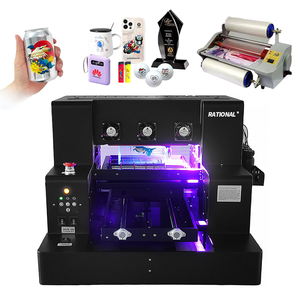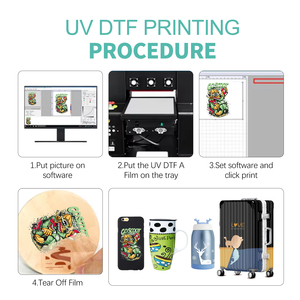
All categories
Featured selections
Trade Assurance
Buyer Central
Help Center
Get the app
Become a supplier

(555212 products available)














































Flexographic Printing
This process involves the use of flexible, relief (raised) photopolymer plates. These plates transfer fluid, low-viscosity inks onto irregular surfaces. Thus, it's ideal for packaging materials such as plastic films and bags. Printing on plastic with this method is useful because it provides high-speed production with excellent ink adhesion. Also, it is good for large runs of the same printed plastic, making it effective for manufacturers.
Screen Printing
Screen printing is thick plastic printing, where ink is pushed through a mesh screen onto the plastic surface. It works well for flat plastics and can print on three-dimensional objects using special techniques. The method provides vibrant colors and a variety of textured effects. This is why it is often standard for promotional items, signs, and product packaging requiring durable, high-visibility graphics.
Digital Printing
Digital printing uses printers similar to desktop inkjet or laser printers. They directly apply the design onto the plastic. This is a versatile process that allows you to print different things without changing the printing plates. So, it is ideal for small plastic printing jobs, custom designs, or jobs that need quick turnarounds. It can be good for banners, labels, and even smaller packaging.
Gravure Printing
The method utilizes engraved cylinders to transfer ink onto plastic surfaces. It produces high-quality images with a smooth finish. The process, though slow and expensive in setup, is ideal for large-scale productions. This technique works best for printing plastic materials used in packaging, especially where quality is more than quantity.
Offset Printing
Offset printing involves transferring an image onto a rubber blanket. Then it applies the image onto the plastic surface. This technique is often used when printing on materials like plastic sheets or films. The print quality is good, producing sharp images. However, offset printing is better for large runs because of the greater setup time required compared to digital printing.
Packaging Industry
The gravure plastic printing makes a good option for flexible packaging materials, such as films, bags, and labels. They help with product branding and information display. It is also helpful in creating attractive and functional packaging that helps the products keep their integrity. The techniques such as flexographic and rotogravure printing are ideal for creating high-quality printed plastic materials that are visually appealing.
Automotive Industry
Plastic printing in the auto sector is useful when creating interior and exterior components. These components include dashboards, trims, and other decorative elements. Screen and in-mold printing provide durable finishes that are able to resist scratching and wear.
Electronics Industry
```Plastic printing``` is useful to label electronics such as keyboards, housing, and control panels. Here, it is critical for such items to carry accurate and aesthetically appealing labels or designs. So, techniques like screen printing or digital printing are about creating customized graphics. They also ensure that the labels are attached to the products permanently and can withstand heat or water exposure.
Medical Devices
In this space, printing is useful for both the packaging and equipment. For example, it can be used for creating custom labels on syringes, containers, and diagnostic equipment. In medical packaging, it is important to maintain hygiene and enable easy identification. This is why techniques like in-mold labeling and screen printing are ideal due to their capacity to produce sanitary and long-lasting labels.
Consumer Products
Screen, digital, and lithographic printing are useful for developing a variety of consumer goods. They help in developing printed plastic for toys, household goods, and appliances. The consumer goods sector favors these printing methods as they offer flexible production runs. This includes a good quality of vibrant colors and intricate designs that enhance the aesthetics of the products.
Signage and Displays
Large signs, banners, and point-of-sale displays often contain printed plastic components. These are useful for their strength and resistance to the weather. The hole printing techniques (especially large plastic printing) work well to provide vibrant, precise prints that are useful for promotional displays and outdoor signs.
Durability
Plastic printing is hard-wearing, providing reliable printed materials. Plastics can be resistant to water, UV light, heat, and chemicals. This means that they eventually maintain their integrity in harsh conditions, unlike paper and wood materials. This durability makes printed plastic good for products such as outdoor signage, packaging, and labels, as well as for usage in and outside the environment.
Versatility
Plastic printing can be useful across different industries and applications. The techniques can contain flexible and rigid materials. Thus making them ideal for packaging, consumer goods, and industrial labels. Also, printing on plastic is useful for developing products with extremely unique sizes, shapes, and graphical designs because of its adaptability.
Cost-Effectiveness for Mass Production
Large-scale production of printed plastic items can be affordable, especially with techniques like flexographic and gravure printing. These methods help offset the initial set-up costs by providing lower material costs and faster printing in the long run. This makes printed plastic ideal for companies that require high-volume output.
Aesthetic Appeal
Digital and screen printing offer vibrant colors and high-resolution graphics on plastic surfaces. This enables good branding and visibility. Also, a range of ink finishes, including glossy or matte, provides design versatility. This helps produce visually captivating products.
Lightweight
Aside from their durability, plastics are lightweight. It makes them practical for applications that require easy handling or transport. Therefore, printed plastics are common in packaging, product design, and promotional items where weight is an important factor.
Users must first identify what kind of product they will be developing in order to choose a certain plastic printing method and material. For example, abs plastic will work for areas that require pressure and temperature, while pmma will work perfectly for lenses and displays.
Next, they must identify what kind of finish they want to achieve. For instance, users will have to decide whether they want a matte or glossy finish and a solid or clear view since different printers and inks will offer different results.
More so, users also must think over what kind of ink they want to use. Typically, water-based inks are more environmentally friendly, but solvent inks are better for tough surfaces like plastic. At the same time, metallic and UV inks provide good colors and finishes.
Then, consider the resolution and detail level of the printed image. High-resolution images will look perfect on the item if the correct method is selected. Low-res images or designs that have block colors can use any just-friendly method like screen or digital printing.
Also, think of the printing technique that suits their project scale best. Screen printing is ideal for bulk orders because it is more cost-effective per unit. Digital printing is best for small amounts because it does not require huge setups and is quicker.
Lastly, consider the plastic type to be printed on. This is because some printing techniques work well with certain kinds of plastics. For example, digital printing creates good results on smooth, rigid plastic. At the same time, screen printing adheres well to textured plastic.
Above all, evaluate the supplier's experience with plastic printing. So, they should ask for samples and reviews of previous work that is relevant to their project to ensure that what they order meets the required standards and quality.
There are several benefits to plastic printing. To begin with, it develops durable and flexible products that tolerate different conditions. It is lightweight, making it easier to deal with and transport. It is also environmentally friendly, as recycling and reusing some kinds of plastics is possible. Most importantly, it is visually appealing, with bright, attractive designs that catch the viewer's eye.
Plastics have different types of printing on them, like digital, screen, and heat transfer printing. Each has advantages over the others, depending on things like the image's complexity and the number of images needed. In digital printing, a special inkjet printer applies the design directly on the plastic for quick small orders. For larger orders, screen printers create a mesh of each color that will be used and presses ink through it onto the plastic. This is more efficient for bigger orders. Heat transfer printing involves sticking a printed design onto plastic using heat and pressure, good for intricate images or custom jobs.
There is a variety of items that are ideal for plastic printing. It encompasses different types of containers, packaging materials like wraps and bags, signage for both interior and exterior, labels for products, promotional items like key chains and cups, and industrial equipment marking such as control panels and labels. Furthermore, it includes toys, architectural elements like window frames and coverings, medical equipment, and custom designs for arts and crafts.